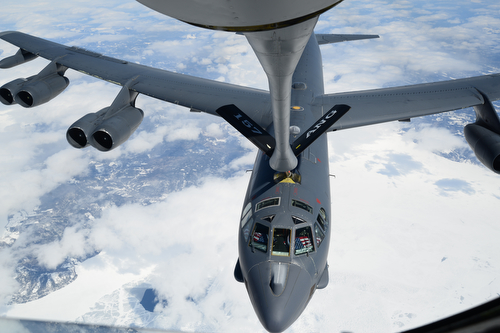ArcticWatch: Mehr russische und amerikanische Aktivität
In und über der Arktis, die für verschiedene Staaten offensichtlich auch militärisch zunehmend interessant wird, verstärken Russland wie die USA ihre militärische Präsenz. An diesem Osterwochenende gab’s dazu zwei Meldungen: Die USA schickten B52-Bomber auf die Übung Polar Growl in die Region, und Russland verkündete die Stationierung des SA-22-Flugabwehrsystems nördlich des Polarkreises.
Aus der Mitteilung der U.S. Air Force:
Two B-52 Stratofortresses from the 5th Bomb Wing, Minot Air Force Base, N.D., and a pair from the 2nd Bomb Wing, Barksdale Air Force Base, La., completed today simultaneous, roundtrip sorties from their U.S. bases to the Arctic and North Sea regions, respectively.
The training mission, coined POLAR GROWL, allowed the aircrews to hone their navigation skills and enhanced their ability to work with Allied partners, while demonstrating U.S. Strategic Command capacity.
„These flights, demonstrating the credible and flexible ability of our strategic bomber force in internationally-recognized flight information regions, are the culmination of months of planning and coordination,“ said Adm. Cecil D. Haney, U.S. Strategic Command commander. „They are one of many ways we demonstrate interoperability, compliance with national and international protocols and due regard for the safety of all aircraft sharing the air space.“
Each of the two legs of POLAR GROWL provided unique training opportunities, all while testing the bomber force’s command and control apparatus‘ ability to support two synchronized flight paths. The bomber crews flying the North Sea route participated in dissimilar air intercept maneuvers with fighter aircraft flown by the Royal Canadian Air Force, the U.K.’s Royal Air Force and the Royal Netherlands Air Force. In addition to conducting dissimilar air intercept maneuvers with Royal Canadian Air Force fighters, bomber crews on the Arctic leg of the mission transited around the North Pole, providing the crews invaluable training in polar navigation.
Und auf russischer Seite:
Russia has already deployed air defense missile and artillery weapon systems Pantsir (SA-22 Greyhound) and plans to place MiG-31 (Foxhound) interceptor aircraft in the Arctic region, deputy head of Russian Aerospace Defence Forces said on Saturday.
“We have already placed there gun systems Pantsir. Deployment of MiG-31 on the Russian Arctic airfield is planned,” Maj. Gen. Kirill Makarov told Russian radio.
New Russian Anti-Aircraft Module Capable of Locating 15 Targets Per Second
Makarov added that MiG-31 jets would protect Russian warships that could sail along the Northern Sea Route in case of any escalation or armed conflict scenario.
Nun ist die US-Übung offensichtlich lange geplant, aber das gleiche gilt für die russische Aktion: Tests des Pantsir-Systems waren im vergangenen Jahr schon angekündigt und in diesem Jahr bestätigt worden.
Die Kollegen von War is Boring haben das auf den Punkt gebracht:
The United States and Russia are currently engaged in a prolonged battle of military theatrics. Both countries are spending time and money to train with their allies and show off fancy equipment … and they’re making damn sure each other can see it.
(Foto: A B-52H Stratofortress from Barksdale Air Force Base, La. receives fuel from a New Hampshire Air National Guard KC-135R April 2, 2015, near the eastern coast of Canada. The B-52H was returning home after supporting a U.S. Strategic Command-directed mission to the Arctic and North Sea regions called „Polar Growl” – New Hampshire Air National Guard photo by Airman Ashlyn J. Correia)




Kindergartenverhalten….
Ein bißchen mehr ist da schon dran.
hi,
kann da im text ein fehler sein? falsche Bezeichung des Russischen Materials?
oder steh ich mal wieder auf dem schlauch?
mfg menjek
@menjek
welcher Fehler, und: in meinem Text oder in dem zitierten Text aus russischer Quelle?
Heise hat dazu einige Artikel in Umlauf gebracht:
http://www.heise.de/tp/artikel/44/44489/1.html
http://www.heise.de/tp/artikel/43/43486/1.html
http://www.heise.de/tp/artikel/42/42735/1.html
Die Größenordnung der RUS EX ARCTIC SNAP ist schon beeindruckend:
http://tass.ru/en/russia/783728
@T.Wiegold
hi,
naja sie schreiben von einem SS-22-Flugabwehrsystems
und untem im text steht
SA-22 Greyhound
mfg
tatsache.
SS-22 wäre eine ausbaustufe dieses Systems
http://de.wikipedia.org/wiki/SS-12_Scaleboard
„9K76 Temp-SM: Modernisierte Version ab 1984, Entwicklung gestoppt. NATO-Codename: SS-22 “
(ist mir beim lesen allerdings auch nicht aufgefallen)
Da hat Menjek nicht ganz unrecht.
Sollte mich mein engl. Abkürzungsfimmel der Bundeswehr (AküFiBw) nicht täuschen, steht SA für Surface – (to) Air was ja bei einem Luftabwehrsystem nicht ganz unpassend wäre.
SS wäre dementsprechend Surface – (To) Surface also Boden-Boden, Mörser, Haubitzen, Mars-Werfer usw.
Im zivilen hingegen… da öffnen wir besser nicht nicht die politische Büchse der Pandora.
*g*
Ah jetzt ja. Warum sagt ihr mir nicht einfach, dass ich da einen Tippfehler drin habe? (Im zitierten Sputnik-Text steht doch SA-22.)
Man sollte die russischen Planungen nicht überbewerten. Das sind Planungen! In der betreffenden Region braucht es erstmal einen einsatzfähigen Flugplatz um dort etwas zu stationieren. Selbstverständlich sollte es SA-22 und nicht SS-22 heißen.
Momentan wird erstmal daran gearbeitet unbemannte, also automatisierte Radarstationen zur Luftraumüberwachung in der Arktis zu entfalten. Das ist gerade mal von Erprobung derselben die Rede. Zurzeit sind dort die Luftlandetruppen aktiv, es stehen da wohl „Such- und Rettungsmissionen“ in Verbindung mit einer driftenden Forschungsstation im Fokus.
@Stefan Büttner
Auch die Amerikaner haben in der Arktis schon Lehrgeld bezahlt (z.B. Abbruch einer größeren Übung wg. Kälteausfällen).
Dennoch denke ich, daß beide Nationen dort dauerhaft militärisch präsent sein werden, ähnlich wie IND-PAK auf dem SIACHEN-Gletscher (in 6000m Höhe).